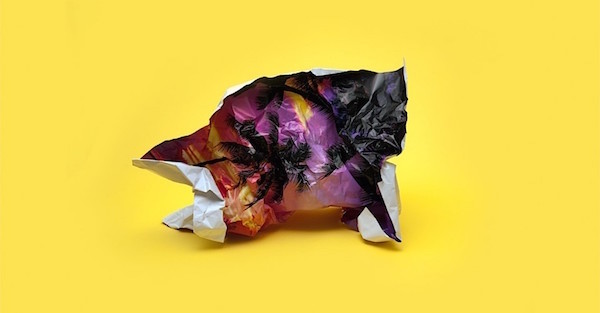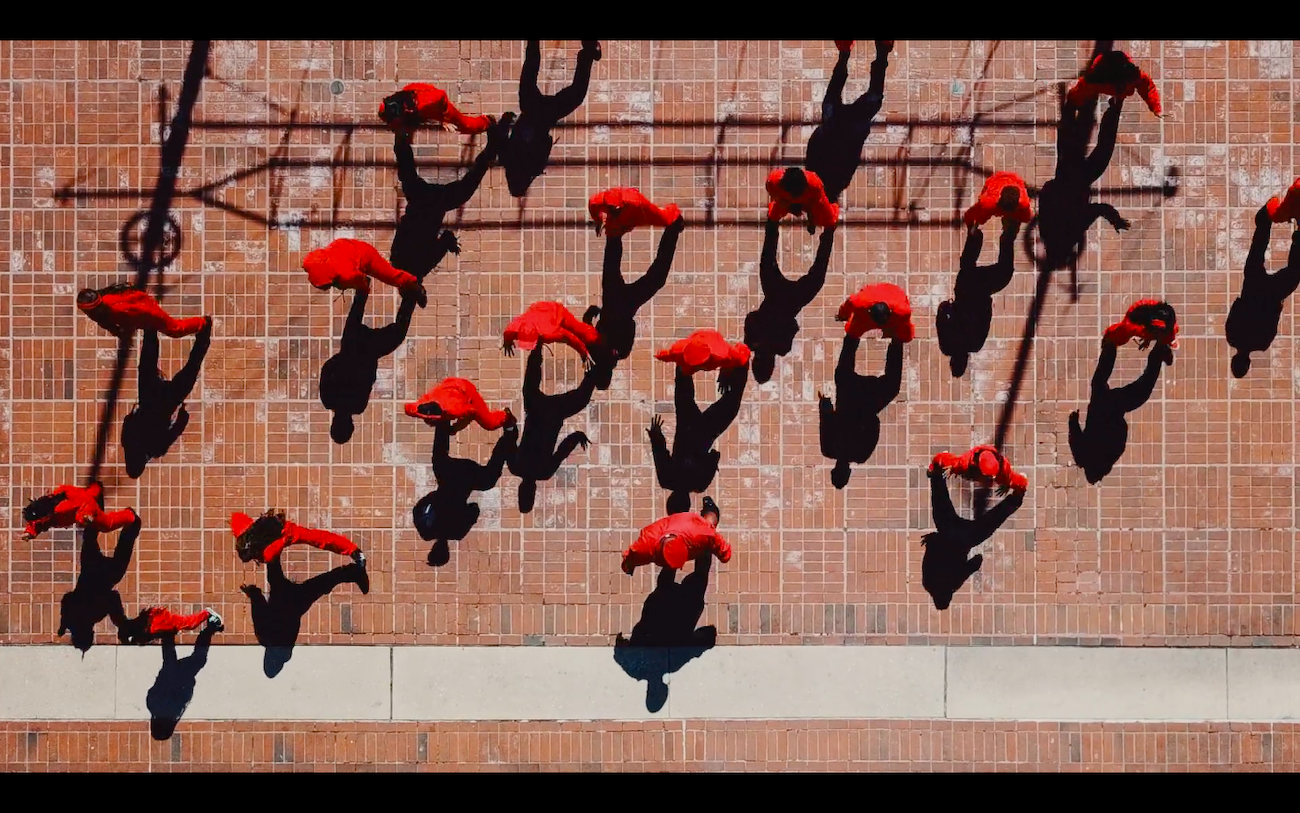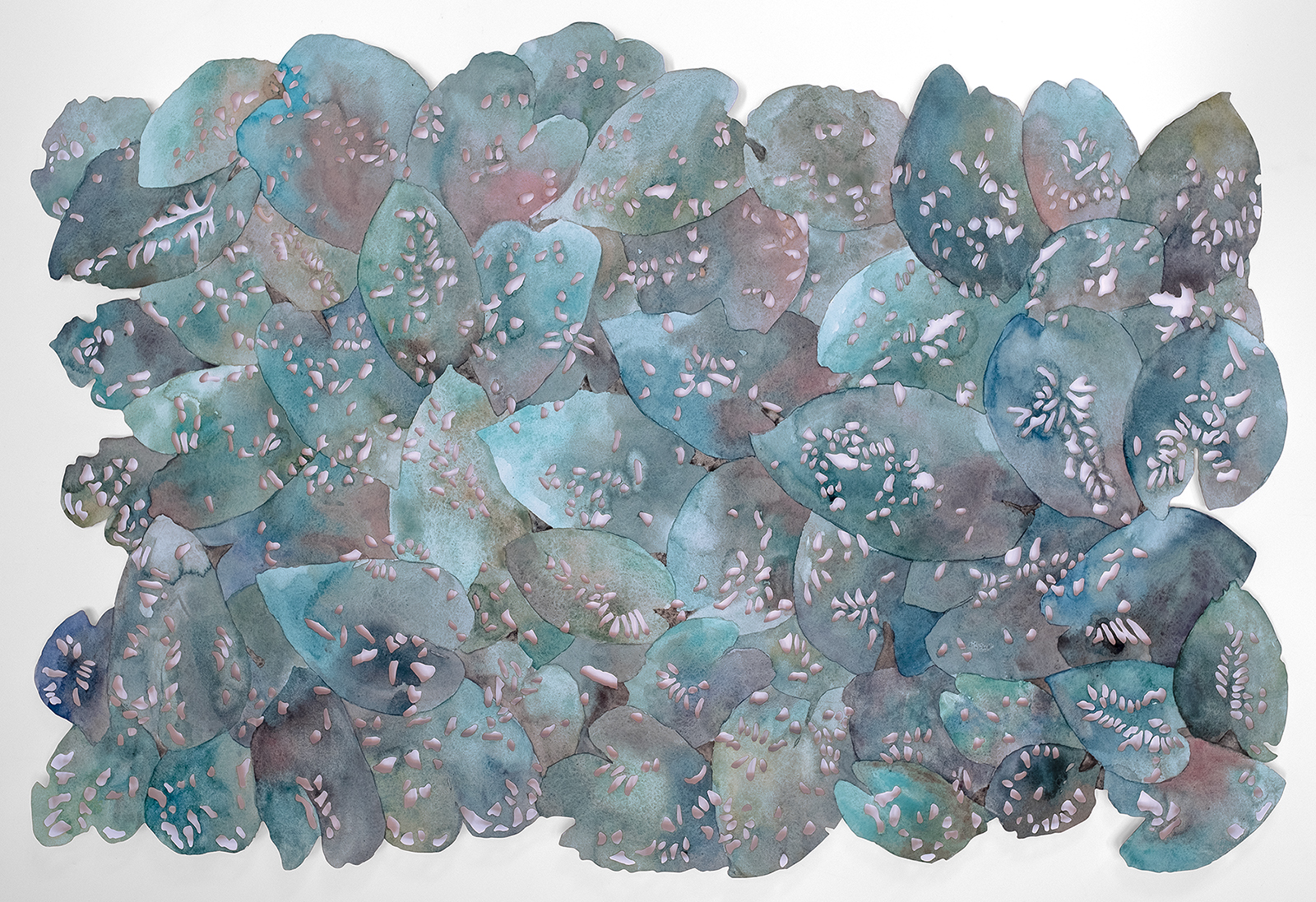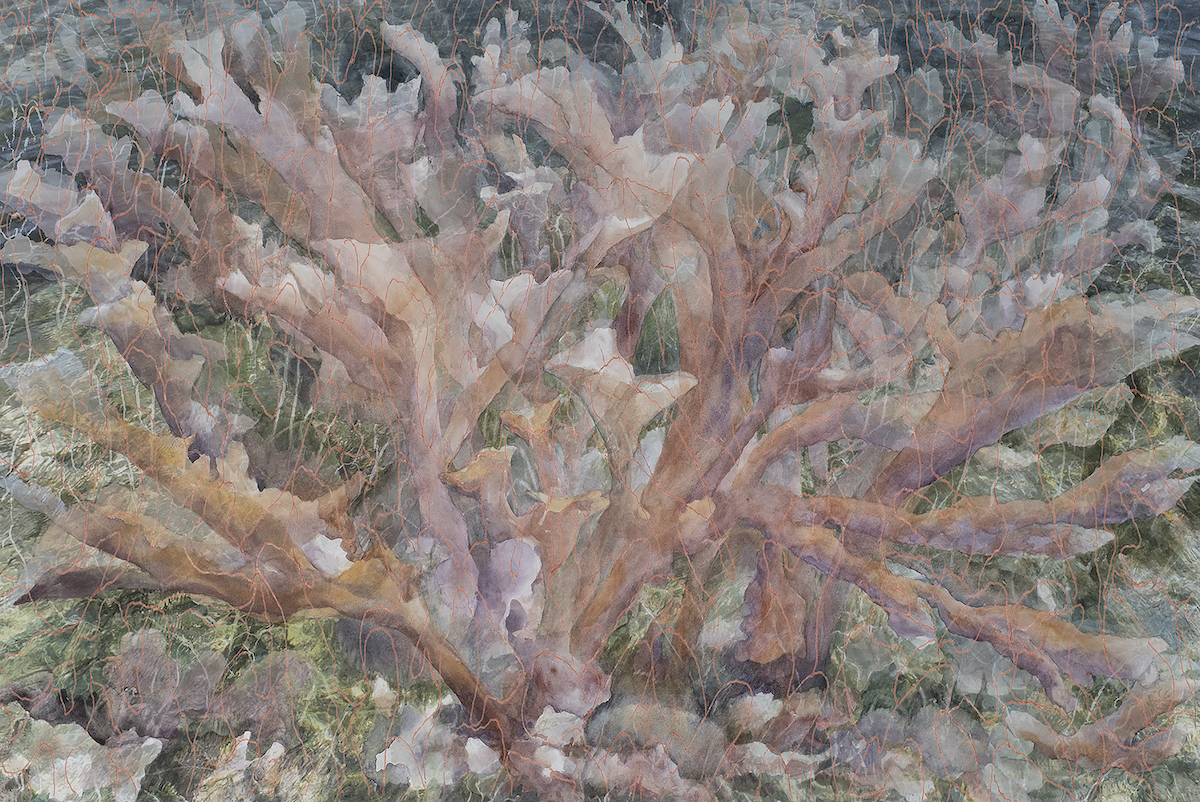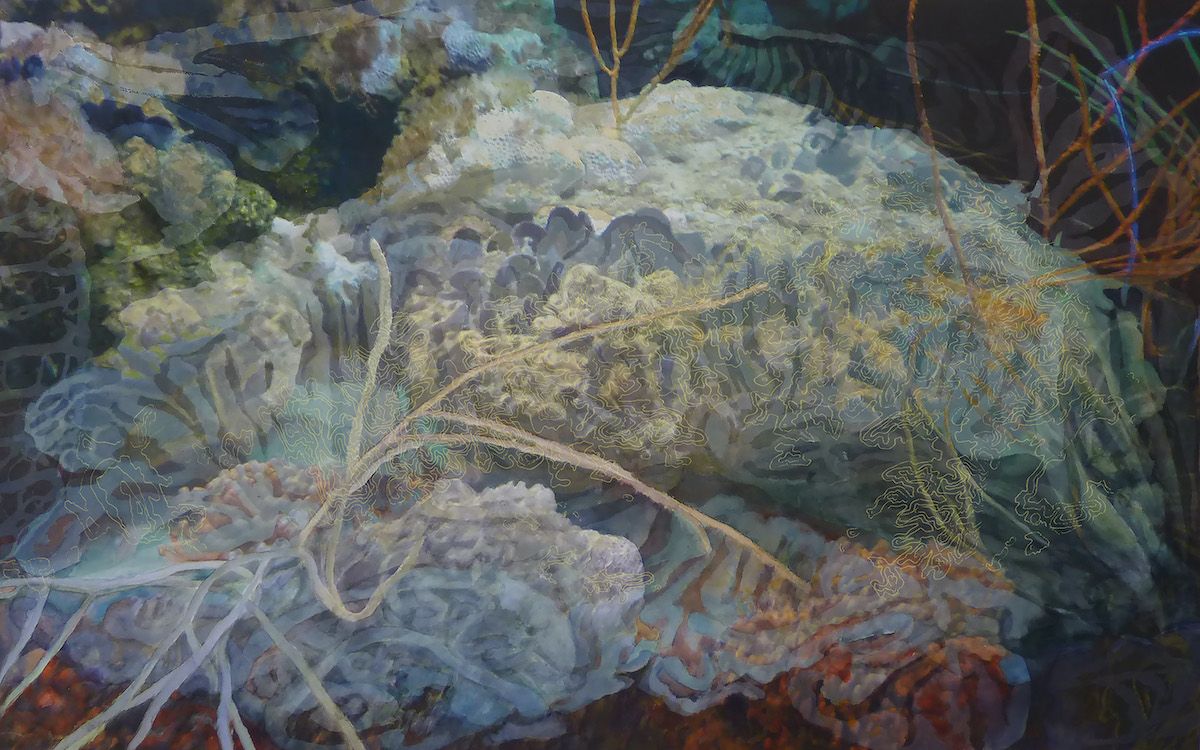For Christine Neill, paper itself is a living, breathing thing. Her watercolor and print works, currently on view at Goya Contemporary, are comprised of many edges, shadows, and cut outs. Neill treats paper with the same reverence as she does her subjects, which are typically plants with a story to tell. Over the last decade, with the help of a number of collaborators, Neill has opened up her once solitary watercolor practice to explore and utilize technical processes that help her pull the viewer’s attention to overlooked elements such as forest floor coverings.
Raised in a family with great fascination for the outdoors and a background in farming, Neill first studied biology before shifting to art. The beloved MICA professor retired last year to paint full time. She recently had two solo shows, one at the Katzen Arts Center at American University in Washington, DC and Invasive, Endangered, Beneficial at Goya Contemporary which closes on January 3. I sat down with Neill to discuss the impact that climate change has had during her lifetime, what it was like to be one of the few mothers at MICA in the 1980s, and her beliefs about an artist’s role in educating the public.

Christine Neill, “Blue Carbon,” 2019, watercolor, archival pigment print on laser-cut paper, 30” x 45”
Suzy Kopf: The couple of the works in your current show, Invasive, Endangered, Beneficial at Goya Contemporary, are made through a process you’ve been developing that combines drawing with photography and photo-editing software. Can you talk about how you combine digital photography with traditional drawing methods?
Christine Neill: I want to do as much painting and drawing as I can. I don’t draw on a tablet. I draw on a vellum that has a great ability to be erased—I love doing the drawing. But I do use the computer to put the drawings and the photographs together and then I have it printed. So the white areas, or thin areas of paint where I want the positive imagery to be, come out white or gray in the printout. I do a couple small test prints to see how they’re going to look before I print it large. The drawings, I am able to superimpose in Photoshop. I have a large scanner so I can put the drawings in and make sure that they’re going to do what I want them to do. The drawings on the plexiglass are printed at Dodge-Chrome in Silver Spring. From there, I can sort of get an idea, and then we fiddle around, sending files back and forth to see what they look like. And who knows. This is as unpredictable as the watercolor, really. By experience you have some idea of what they are going to come out as.
Two of the pieces in your show, “Holey Leaves, Emerald” and “Blue Carbon” at Goya, also have laser-cut parts. Can you talk about how you started including that element in your painting practice?
I asked a student of mine if she would help me use the laser cutter at MICA. I had two of them made and I took them to my residency in 2017 at the Studios of Key West and worked on them. It’s laser cut first and then painted on top and I realized I really liked it.
“Blue Carbon” is what the wetlands are sequestering; they are storing the CO2 and keeping it out of the atmosphere, which is so critical. So I wanted there to be that kind of depth; there is something else underneath there. I had the holes done first and then I took it to the art tech lab and they printed on top of it. I work to have the elements of the piece relate to the ground as much as I could in the painting of it.
Your subject matter is typically plants that are in the process of dying, decaying, or otherwise impacting or being impacted by their environment. Do you think people are starting to get the point?
I think that things are beginning to sink in, in places. I think there are people who are beginning to understand and when I talk to people about these paintings, they’ll say, “Oh, they’re so depressing, all of these horrible things you’re painting. They’re beautiful paintings, but they’re so depressing.” And my point is that’s what’s happening. You know, we’re not necessarily aware of all these things that are going on.

Christine Neill, “Disappearing Cavendish,” 2017, watercolor, archival pigment print on paper and framing Plexiglas, 31” x 44”
Do you think it’s the job of us as artists to call people’s attention to things, like climate change, that are happening that they’re not acutely observing?
In a general sense, I think that as an artist that is really a personal decision, right? In [the image list for this show at Goya] my field notes give a little more explanation and that’s fine, I don’t think I need to go into great detail.
I do feel so strongly about this climate crisis that we definitely are in. It’s not going to be my problem, but you know, I have granddaughters. I do care about the beauty of it all and how important it is to be in a world where you interact with nature. I live in the city half the year, deliberately, but that interaction is just so essential to our well being psychologically and physically. Maybe in the next exhibit, I will actually have wall text that doesn’t explain it away but adds something to the image.
When I was walking on the beach in Puerto Rico collecting stuff, that’s when I realized that white coral is dead, it’s not just bleached. There was a piece on white coral in my Washington, DC show [at the Katzen Arts Center] that I called “White Death.” It’s called white death syndrome and incidentally, “white death” is what they called tuberculosis. The corals have algae and that’s what gives them the colors and their nutrients. And when those algae die, that’s not good. It’s sad. It’s depressing. White coral is beautiful, but it’s beautiful in the way that a bone is. I bet you’ve heard about the Cavendish bananas?
Please, tell me about the Cavendish bananas! Were they the first ones?
Actually, the original ones in the ‘50s were called “Gros Michel.” The big Michael. And in the ‘50s, early ‘60s, that’s where the whole history is tied to the banana republics and the big agribusinesses that took it up—there’s a whole book on it, Banana by Dan Koeppel. The easiest thing for them to do was, not just in Central America but worldwide, to plant the same plant. So it’s a monoculture of bananas. Every banana was genetically the same. So then a fungus came along and they’re all dying off. They found, in England, in the Cavendish estate, [Chatsworth House], a greenhouse with what seemed like a banana that was going to be resistant to that fungus. And so what did they do? They planted it worldwide again! This happens again and again, somebody’s got to be a little smarter. It’s taken 30, 40 years but now the Cavendish bananas are no longer resistant or the fungus has changed enough. So I painted “Disappearing Cavendish.” There’s a phrase, “biology loves diversity.” And it’s so true.
I know your previous bodies of work have dealt with landscape in large scale, and I’m thinking of the riverbed piece in the BMA’s Special Collections and the stacked rock works you made for some time. Despite using some of the same materials, would you say that this work is a shift, perhaps from the large scale to the more microscale?
I don’t think that it was a conscious decision as much as it was to be able to focus on these different species and climate change. I am able to look at many of them in their whole life cycle; one of the wonderful things about plants is you get to see the life cycle in a way that you don’t with human life. In the spring, trees come to life. You can even see it in houseplants, how they go dormant in winter. Some of it may have to do with the collecting; before I hadn’t been collecting as many things. Part of it may have been being able to take these smaller things and enlarge them as opposed to reducing the larger experience down.

Christine Neill, “Greenbrae Duff,” 2019, watercolor, archival pigment print on Arches paper and framing Plexiglas, 27” x ”40”
For me, the plexi and the drawing layers are functioning in this way where there’s almost motion even though the paintings are obviously still. By giving us multiple layers at once, it’s as if the breeze is blowing or the ocean is pushing back and forth over these shapes. Is that intentional or is that a nice side effect?
I think it really is the imagery I’m working with and just being familiar with it and knowing that they have the motion inside of them. The last time I was in California visiting my brother, he was raking up the acacia seeds up out of his driveway and that motion inspired the way I composed “Greenbrae Duff.”
This connection with motion also links with the passage of time that I’m seeing in your work, because as with the coral one, it’s a memorial for something that’s dying right in front of us. And then with other works I see time references, like a moon cycle, in “Sido’s Cactus,” is that correct?
Definitely. The idea of moving from either left to right. In the Berkshires, our house faces south and when there’s a full moon we can watch the stages of the moon go by. I included the moon cycle in this piece because I was thinking of a story Colette wrote about her mother, Sido, who cancelled a visit to Paris because her cactus was going to bloom. It is here specifically because of Colette and her mother and the cactus that is so fragile and happens so infrequently. I wanted that idea of movement, yes. It is life-cycle changes and about the choices that we have to make between these events in our life and what, subsequently, I feel that as a species living on this earth, we’ve got to do what we can before it’s totally gone or it will be unalterably changed.
There are species that are just dying out. Can anyone figure that out by just looking at it? No, not without my explaining it, but I’m hoping—to go back to your previous question about responsibility of the artist—it enriches the painting. These works are not just another pretty plant.
Christine Neill, “White Death,” 2019, and “Reef,” 2017, watercolor, archival pigment print on paper and framing Plexiglas, 34” x 47.75”
In your earlier works you were painting independently and now you have so many collaborators that help you with aspects of putting a painting together. What do you think about that shift?
That’s what the model was. Have you read the Ninth Street Women? The writer, Mary Gabriel, went to MICA, and she gives the background in how Nazism really affected the artists in New York, with the traditional Surrealist and other male artists coming into the scene in New York. It’s just so appalling. After the war is over, we all know, Rosie the Riveter had to give up her job, there were official documents written, and now, wives, you have to service your husband, make a beautiful house for them, etc. You get the feeling there was a community but there wasn’t much collaboration in the work because it was about finding yourself and expressing yourself on that canvas. I had only male teachers when I was at Skidmore College for Women and they were really unfriendly people! They were not nurturing in any way at all. That’s what I grew out of and what I knew how to do when I got to MICA. Grace Hartigan, on the other hand, really did nurture her female students, that was important to her.
After graduating in 1971 from MICA, you stayed in Baltimore, right?
Yes, I stayed in Baltimore hoping to get a teaching job. Name a school, I probably taught there, including MICA. At that time, the evening classes were all three credits, open to day school students. I did a couple of one-year gigs to begin with and then was hired full-time. It was probably 1980 or later before I had a full-time teaching gig. It’s a much richer time now; people have chosen to stay in Baltimore. It was very slim for a while.
I imagine you were one of only a few female professors at that time?
Yes, I wasn’t the only one but there weren’t very many of us. My son was born in 1979, and I was one of the few female professors who had children in that era—Leslie King Hammond had a child and Jane Elkington had a couple. That’s it! You know, women said, “I won’t get married, I won’t have children.” And even in the Ninth Street Women, they’re struggling with this and making this decision. And Grace had a son who lived with her in New York until he was 12, and then she gave him up.
Slowly I have watched the younger males, they take responsibility for their children, they come to lectures or whatever. Those attitudes have changed a great deal. And some of the younger women faculty manage, even living in New York. For me, it was something I very much wanted, so I made it work. I had a studio at home, I was able to work after bedtime. I know that having a child made me a better teacher. I would take my son out and say, let’s go on a hike and see what we can collect. I do that now with my granddaughters.

Christine Neill, “Sido’s Cactus,” 2019, watercolor, archival pigment print on paper and framing Plexiglas, 27” x 40”
Do you have a daily drawing practice or how often are you making drawings in your sketchbook?
It’s when I need it. It’s frequent. I always have a notebook with me. Those times where nothing else is going on, I will sit and draw. If I see something, I use the notebooks often to collect things and save them for later. It would be a really great idea to have a daily practice but for me, it’s more fluid than that. Some of the notebooks are sketchy and some have more formal drawing. In the sketchbooks, it’s like, “We’ll try that. Let’s see where that happens.”
You’ve been painting professionally since 1971. That’s already a long career any artist would aspire to. What have you observed in that time?
Last spring we went to my college 50th reunion and we were looking at one another like, No, it can’t have been that long! But it is a long time. One of the positive things is that I have seen historical change and that can be very satisfying. I also have seen the environment change in that period of time. Elm trees that grew on my street when I moved in 40 years ago, they lined the street. They’ve been long gone. Growing up, we spent a week every summer on Cape Cod and that changed so dramatically. John Kennedy did a really positive thing establishing the National Seashore in the early ‘60s, but we used to walk out into the water and continually cut our feet on the razor clam shells. You can’t find a razor clam anymore. My dad would take the rake and say, “We’re having chowder tonight,” and come home with a bucket of clams. I have observed those real changes. If I, in my short human life, can watch this happen, it’s a really dramatic thing. That’s one of the few regrets that I have is that I’m not going to live long enough to see how this plays out.
Invasive, Endangered, Beneficial is on view at Goya Contemporary through January 3.
Featured image: “Holey Leaves, Emerald,” 2019, watercolor on laser-cut paper, 24” x 36” (photo by James Sangewald)
All other photos by Michael Koryta
